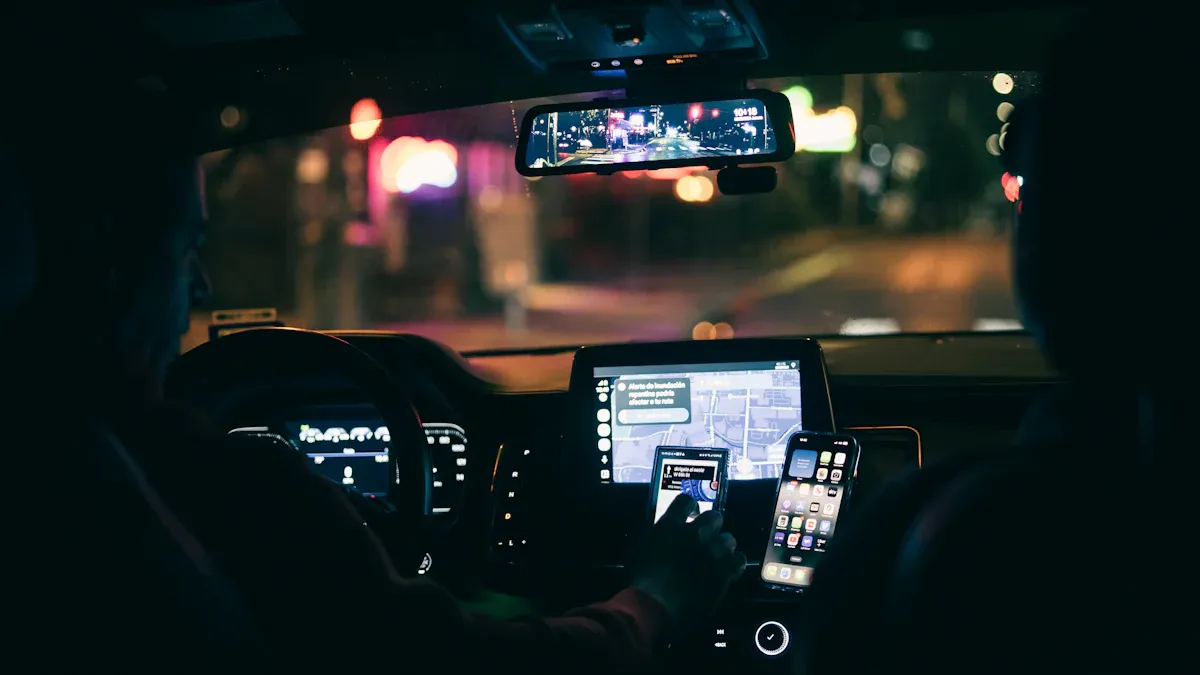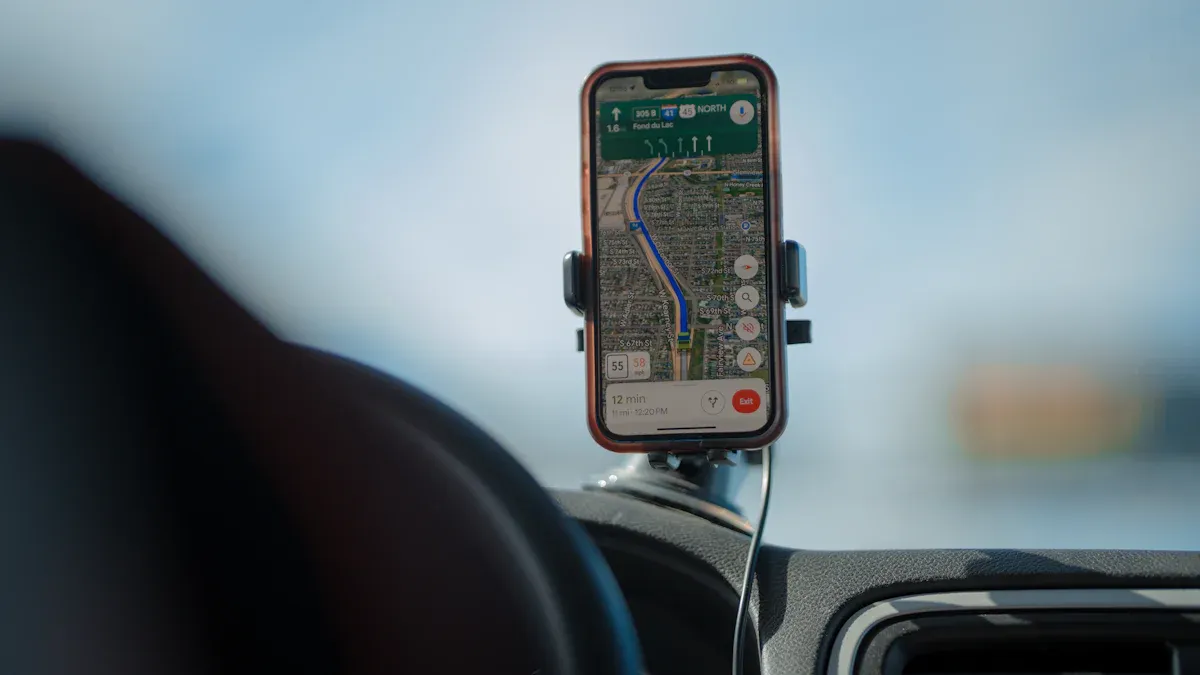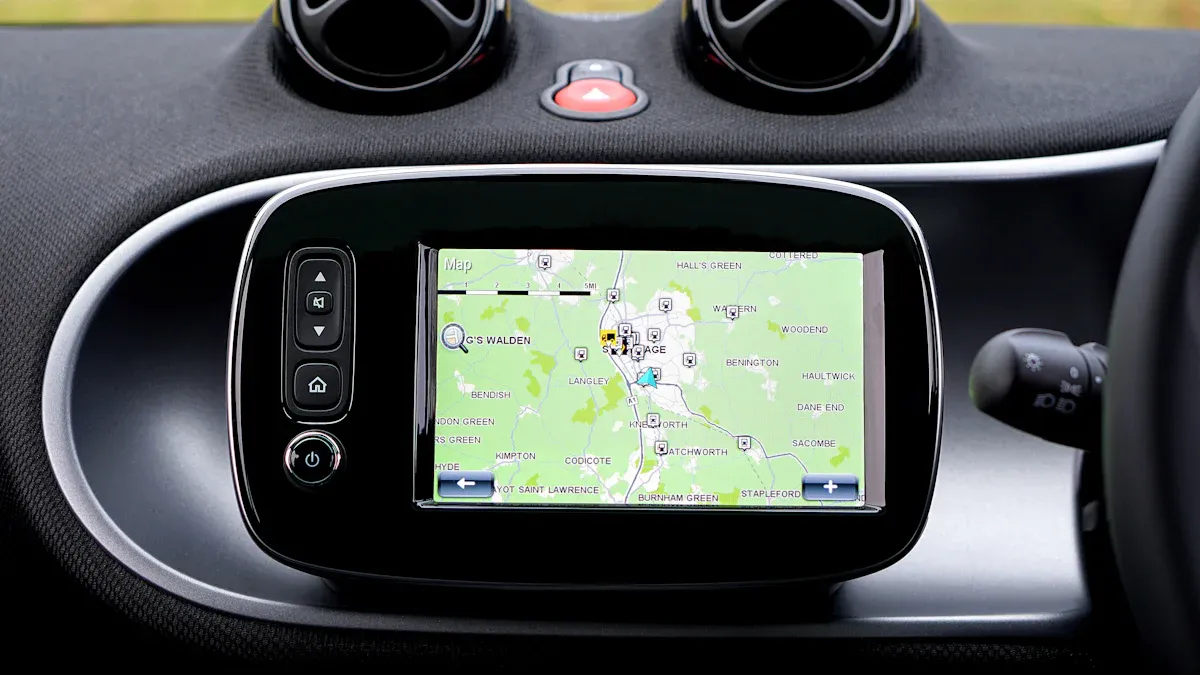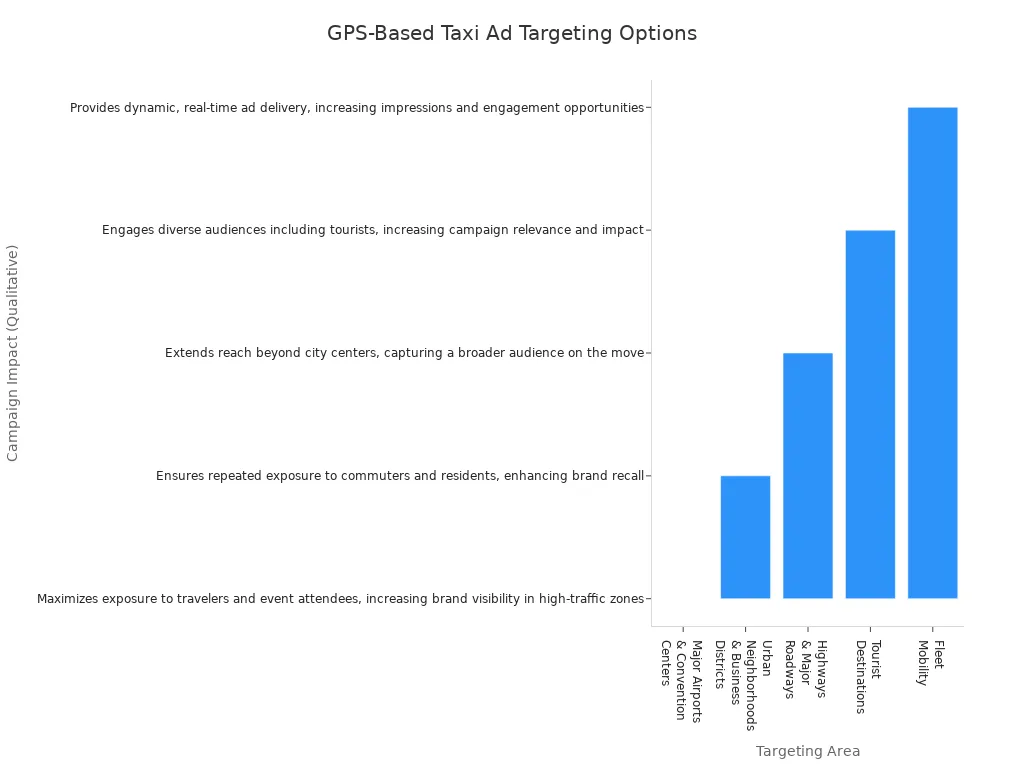
GPS-Based Geo-Targeted Advertising helps taxis and rideshares reach people better. Real-time location data and geofencing let these cars show ads that fit where riders go. Advertisers get more accuracy and better data. Drivers earn more money and find the system simple to use. This technology uses location to make each ad matter more to the people who see it.
Key Takeaways
GPS-based geo-targeted advertising uses live location data. It shows ads that fit where taxis and rideshares go. This makes ads more useful and helps them work better.
Features like geofencing and dynamic content switching help ads change fast. Ads can change by location, time, or events. This keeps messages new and fun.
Advertisers get better targeting and more control over campaigns. This helps them reach local people and boost sales.
Drivers and fleet owners can make extra money by showing ads. The setup is easy and updates happen by themselves. This does not stop their work.
Strong privacy and data protection rules help passengers trust the system. They keep personal information safe and make the system work well.
GPS-Based Geo-Targeted Advertising Features

Real-Time Location Tracking
GPS-Based Geo-Targeted Advertising uses real-time location tracking to show ads that fit where the car is. GPS, Wi-Fi, cell towers, and Bluetooth beacons help find the taxi or rideshare’s spot. This information lets advertisers pick ads that match where the passenger is, how they travel, and what is happening nearby. When a car moves into a new place, the system can change ads right away. This makes ads more timely and useful. Passengers often see these ads because they connect to what is around them. This way, more people pay attention and ads work better than old styles of advertising.
Real-time tracking lets companies send deals and improve ad delivery based on where the car goes, making each campaign work better.
GPS: Gives exact location data for moving cars.
IP address location: Shares basic info like city or state.
Wi-Fi and cell towers: Guess location by checking signals nearby.
Bluetooth beacons: Find devices close by for better accuracy.
Geofencing
Geofencing makes invisible lines on a map using GPS or other location data. When a taxi or rideshare enters or leaves these lines, the system can show a new ad or send a message. Admins set up geofences by picking spots on a map and choosing rules like center points and alerts. This helps track cars, manage prices, and send special offers to riders.
Geofences are made on digital maps to show where cars can go.
Admins pick rules for each geofence, like alerts or prices.
The system watches cars in these areas and acts when they cross lines.
Geofencing helps with changing prices, safety alerts, and following rules.
Special offers can go to people in certain places.
Geofencing helps keep customers interested, saves resources, and makes service better.
Dynamic Content Switching
Dynamic content switching lets ad screens change messages fast based on place, time, or other things. The system uses live data and smart tools to switch ads as the car moves. Creative templates and geo-targeting tools make it easy to show new headlines, pictures, or actions for each spot.
Live data makes sure ads fit the place.
Templates let content change easily.
Content management systems help update ads automatically.
Analytics check how ads do in each place for better results.
Dynamic content switching makes ads more interesting and gets more attention. Passengers spend 15–30 minutes in the car, so they notice ads more. Fun features like games or surveys get people to join in. Advertisers can react to local events, weather, or deals, so ads stay fresh.
Route and Time Targeting
Route and time targeting lets advertisers change ads for certain routes, neighborhoods, or times. GPS-Based Geo-Targeted Advertising uses live data to find busy places and times. Advertisers can pick ads for morning rides, weekends, or special events.
Ads change with the car’s route and time.
Campaigns target people and interests in each place.
Busy routes help more people see the ads.
Local plans connect brands with people in the area.
Customization Aspect | Description |
|---|---|
Watches ad spots live for up-to-date views. | |
Historical route analysis | Looks at old routes to plan better campaigns. |
Frequency of data updates | Changes how often location updates come in. |
Strategy adjustment | Changes ad spots using location and people data. |
Integration of GPS and analytics | Puts data together for good tracking and reports. |
Advertisers can match campaigns with more app downloads, store visits, or bookings. Promo codes and groups help check how well each campaign works.
Programmatic Ad Delivery
Programmatic ad delivery uses computers to buy and sell ad space fast. In taxis and rideshares, this system uses GPS and maps to show ads based on where the car is. Advertisers can pick small areas, like neighborhoods or special places, and change ads quickly.
Ads use place, time, and live data to fit the moment.
Audience targeting shows ads near important spots.
Real-time changes let ads switch fast.
Mobile tagging and retargeting follow users who see ads.
Data tools check what happens after people see ads.
Programmatic ad delivery makes campaigns work better and faster. Brands can reach the right people with the right ads, getting more attention and better results.
Analytics and Measurement
Analytics and measurement tools help advertisers see how well GPS-Based Geo-Targeted Advertising works. These tools watch how many people see the ads, how many click, and how many buy. They also sort people by age, actions, and place.
Tool Category | Examples | Key Functions and Metrics Measured |
|---|---|---|
Python, R, Google AutoML | Guessing, targeting | |
Ad Delivery Platforms | Google Ads, Facebook Ads Manager | Geo-targeting, changing ads, budget control |
Customer Feedback | Zigpoll | Live feedback, mood checks |
Geo-fencing Platforms | Google Local Campaigns, Simpli.fi | GPS-based ads inside set areas |
Engagement Monitoring | Google Analytics, Salesforce | UTM tracking, conversion paths, click rates |
Budget Optimization | Google Ads rules, Facebook Ads | Changing budgets as needed |
Advertisers use this info to make campaigns better and get more for their money. Checking results often helps each ad reach the right people at the right time.
How the Technology Works

System Integration
System integration is very important for GPS-Based Geo-Targeted Advertising in taxis and rideshares. Each car uses hardware and software to get GPS data, control ads, and show messages on screens. The system needs a few things to work well:
Control cards must have GPS geo-fencing and offline playback. This lets ads keep playing if the network stops, like in tunnels or faraway places.
A steady power supply is needed. Cars use their own power, so backup power helps if the engine turns off.
Modular hardware and safety features, like surge protection and waterproofing, help the system work in tough places.
Cloud-based management platforms let people schedule and check the system from far away. These platforms must work well with both hardware and the network.
Offline playback lets screens show saved ads when the network is down, so ads keep running.
Note: If the system parts do not match or work together, ads may stop playing and the system will not be reliable.
User Interface
Advertisers and drivers use easy dashboards and mobile platforms to control the system. Some important features are:
Simple location targeting, like picking a radius or ZIP code, helps advertisers aim their ads.
Mobile-friendly design makes it easy for everyone to use.
Drivers get quick alerts and clear buttons, like ‘Get Directions’, to use ads.
Landing pages for each place give special deals and contact info, which helps more people buy.
The system works with popular apps like Meta, TikTok, and X, so ads reach more people.
Being open about how data is used and keeping privacy settings clear helps users trust the system and follow the rules.
Targeting Options
Advertisers have many ways to target people and make their ads work better. Digital signs, like taxi top LED displays and inside LCD screens, show ads that fit the place. Interactive screens inside cars let ads change for different passengers, so more people pay attention.
Description | Impact on Campaign Outcomes | |
|---|---|---|
Geographic Targeting | Shows ads near airports, tourist spots, business areas, and events | More people see ads in busy places |
Demographic Targeting | Makes ads for certain groups or ages | Ads are more interesting and people notice them |
Ad Formats | Uses wraps, LED displays, and digital screens | People remember brands and interact more |
Digital & Interactive | LCD screens change ads for each passenger | Passengers join in and ads work better |
Data Analytics & Feedback | Uses live data and feedback to improve ads | Campaigns get better results and more value |

GPS-Based Geo-Targeted Advertising uses these tools to get good results. Advertisers can use data and feedback to make ads better, so more people notice and companies earn more.
Advertiser Benefits
Precision and Relevance
Advertisers get very good accuracy with GPS-Based Geo-Targeted Advertising. This technology uses GPS and IP data to show ads right where each car is. Brands can reach people in certain neighborhoods, near events, or close to stores. Studies show location-based ads work best when people are inside stores. In-store ads make people pay more attention and work better for some groups. Geofencing makes invisible lines, so ads only show when cars enter special places. This stops ads from being wasted and helps companies earn more money. Almost 90% of marketers say they get more sales from location-based ads. Local brands get noticed more as ads reach people nearby, bringing more people to stores and helping build strong customer bonds.
Location-based targeting makes messages fit each group.
Geo-targeted ads show the right content, making users happy.
Advertisers use location data to make campaigns better.
Campaign Flexibility
GPS-Based geo-targeted systems let advertisers change campaigns fast. Real-time updates help brands switch ads by place, time, or what is happening. Advertisers can run short ads for special days or local events. Lots of user data helps ads match the right people and how they travel. Taxi and rideshare cars have people inside, so in-car ads work well. Fun things like QR codes and surveys get people to join in and connect with brands.
Real-time updates keep ads fresh and on time.
Geographic targeting lets ads fit each place.
Bright LED screens help ads stand out in busy cities.
Tip: Brands can quickly change ads for special deals, so messages stay strong during the campaign.
Performance Analytics
Advertisers get strong tools to check how their ads do. Real-time data shows how many people look at and act on ads, so brands see what works. AI tools change ads by time, who is riding, and where the car is. Reports give clues about what people like, so companies get more for their money. Cloud systems help run big campaigns and track how far ads go. Things like QR codes help people join in right away and make ads work better.
Real-time analytics watch how people react to ads.
AI tools help make ads fit each person for better results.
Cloud systems make it easy to check and report on ads.
Advertisers use these facts to make plans better, get more results, and make sure every dollar counts.
Driver and Fleet Benefits
Extra Income
Drivers and fleet owners can make more money with GPS-based geo-targeted advertising. When they put digital ad screens in their cars, they get a new way to earn. Every time an ad shows up, the driver gets paid. Cars in busy places earn even more. Some companies pay for each ad people see. Others give extra money for driving to certain places or at special times.
💡 Tip: Drivers can earn more by working during busy times or on popular roads.
Fleet owners also get more money. They can put ad screens in many cars and control ads from one place. This helps them see how much each car makes and plan better routes for more ads. Many fleets use this extra money to fix cars or buy new ones.
Main ways drivers and fleets earn extra:
Getting paid for each ad shown
Extra pay for special places or events
Sharing money in big fleets
More money for ads during busy seasons
Simple Participation
It is easy for drivers and fleet managers to join GPS-based advertising. Most companies give the screens and set them up. Drivers just need to keep the screens on and connected. The ads change by themselves, so drivers do not have to do anything.
A quick sign-up helps drivers start fast. Training and help teams answer questions and fix problems. Fleet managers use simple dashboards to watch all cars and see money earned right away.
Step | What Drivers Do | What Fleets Do |
|---|---|---|
Sign Up | Join with the company | Add cars to the program |
Install Hardware | Let them set up screens | Plan installs for all cars |
Start Earning | Drive like normal | Check money and results |
Drivers and fleets have an easy time. The system works by itself, so they can focus on giving good rides to passengers.
Privacy and Transparency
Data Protection
GPS-based advertising systems in taxis and rideshares use private data every day. Companies collect where cars go and some personal details from drivers and riders. If companies do not protect this data, it can be at risk. In 2016, hackers broke into Uber’s system and stole many records. This happened because some passwords were not safe. That event showed why strong data protection is important.
To keep data safe, companies use many safety steps:
Secure ways like TLS keep data safe when sent.
Multifactor authentication stops people who should not get in.
Intrusion detection systems look for strange actions.
Practice drills help teams get ready for real attacks.
Data is deleted fast when it is not needed anymore.
Companies follow privacy laws like GDPR and state rules.
Privacy programs help lower legal problems.
General Motors uses many types of safety steps. They make sure their partners do the same. Data like where cars go or how drivers act is kept for a set time, from six months to six years. After that, companies remove names or throw the data away. These steps help keep customers safe and protect their rights.
Data Type | Retention Period | Protection Measures |
|---|---|---|
Precise Geolocation | 6 months – 6 years | Encryption, access controls, secure storage |
Driver Behavior Data | 6 months – 6 years | Regular audits, limited access |
Personal Information | As needed | De-identification, prompt deletion |
Passenger Trust
Passengers want their privacy when they ride. Companies need to earn and keep this trust. Clear privacy rules tell what data is collected and how it is used. Riders should know when and why their location or details are shared.
Being open helps people feel safe. Companies give easy ways for riders to see or delete their data. Privacy settings let users control their own info. Updates about privacy show that companies care about safety.
🚦 Good privacy rules do more than follow laws. They help passengers feel safe and trust the system.
When riders trust the system, they feel safer and pay more attention to ads. This trust helps keep customers happy and helps the business grow.
GPS-Based Geo-Targeted Advertising changes how taxis and rideshares show ads. It helps advertisers and drivers with better, flexible campaigns. Companies should do a few important things:
Keep software up to date all the time.
Make sure private data stays safe.
Use geofencing to send special offers.
Look at data to find better routes.
Teach workers how to use the system.
Privacy is very important because user data is private. Keeping this safe helps people trust the company and keeps business strong.
Some big trends are live digital screens, ads for small areas, changing content, and green choices. Companies that use these ideas can get more people interested and stay ahead of others.
FAQ
What is geo-targeted advertising in taxis and rideshares?
Geo-targeted advertising uses GPS to pick ads for each car’s spot. Advertisers can reach people near stores or events. This makes ads more useful and helps brands talk to local people.
How do advertisers control which ads display?
Advertisers use a dashboard to pick places, times, and who sees ads. The system changes ads by itself as cars move. Brands can switch ads fast for local events or sales.
Is passenger data safe with GPS-based advertising?
Companies keep passenger data safe with strong security steps. They use encryption, update software often, and limit who can see data. Riders can check privacy rules and change their own settings.
Can drivers earn extra money with these ad systems?
Drivers and fleet owners get paid for showing ads. They earn more in busy places or during big events. Most companies make it easy to join and update ads, so drivers can focus on driving.
What types of ads appear on taxi and rideshare screens?
Screens show digital ads, videos, and things you can click. Some ads have QR codes or games. Advertisers can pick ads for certain places, times, or groups of riders.
See Also
Best Motorcycle GPS Units Featuring CarPlay And Android Auto
Guide To Using CarPlay For Streaming And Browsing Safely
Comparing Top CarPlay Dongles That Support Netflix Streaming
Leading CarPlay Adapters Designed For VW Golf Models 2025
Budget-Friendly Portable CarPlay Devices Suitable For All Drivers
